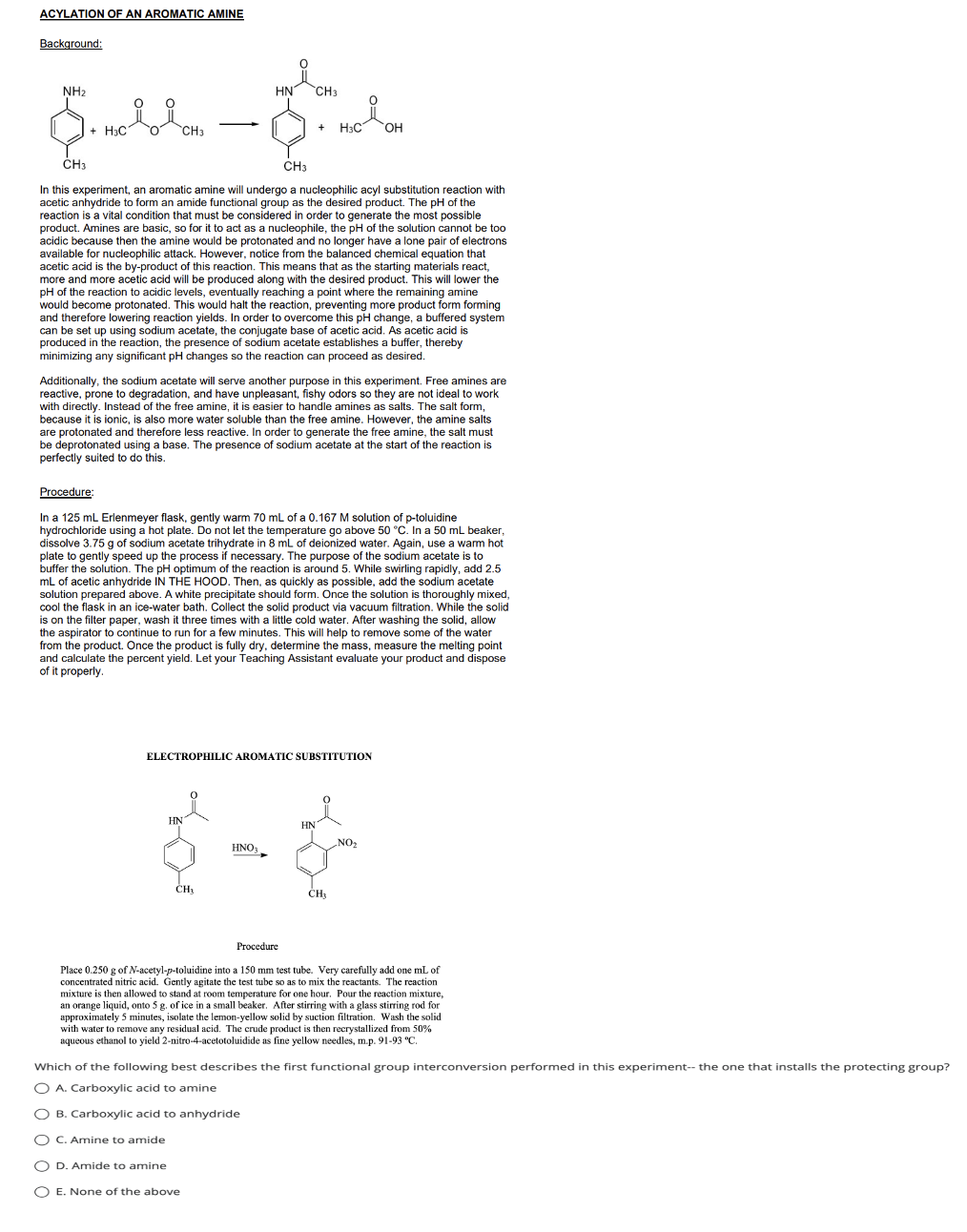Home /
Expert Answers /
Chemistry /
acylation-of-an-aromatic-amine-background-in-this-experiment-an-aromatic-amine-will-undergo-a-nu-pa519
(Solved): ACYLATION OF AN AROMATIC AMINE Background: In this experiment, an aromatic amine will undergo a nu ...
ACYLATION OF AN AROMATIC AMINE Background: In this experiment, an aromatic amine will undergo a nucleophilic acyl substitution reaction with acetic anhydride to form an amide functional group as the desired product. The of the reaction is a vital condition that must be considered in order to generate the most possible product. Amines are basic, so for it to act as a nucleophile, the of the solution cannot be too acidic because then the amine would be protonated and no longer have a lone pair of electrons available for nucleophilic attack. However, notice from the balanced chemical equation that acetic acid is the by-product of this reaction. This means that as the starting materials react, more and more acetic acid will be produced along with the desired product. This will lower the of the reaction to acidic levels, eventually reaching a point where the remaining amine would become protonated. This would halt the reaction, preventing more product form forming and therefore lowering reaction yields. In order to overcome this change, a buffered system can be set up using sodium acetate, the conjugate base of acetic acid. As acetic acid is produced in the reaction, the presence of sodium acetate establishes a buffer, thereby minimizing any significant pH changes so the reaction can proceed as desired. Additionally, the sodium acetate will serve another purpose in this experiment. Free amines are reactive, prone to degradation, and have unpleasant, fishy odors so they are not ideal to work with directly. Instead of the free amine, it is easier to handle amines as salts. The salt form, because it is ionic, is also more water soluble than the free amine. However, the amine salts are protonated and therefore less reactive. In order to generate the free amine, the salt must be deprotonated using a base. The presence of sodium acetate at the start of the reaction is perfectly suited to do this. Procedure: In a Erlenmeyer flask, gently warm of a solution of p-toluidine hydrochloride using a hot plate. Do not let the temperature go above . In a beaker, dissolve of sodium acetate trihydrate in of deionized water. Again, use a warm hot plate to gently speed up the process if necessary. The purpose of the sodium acetate is to buffer the solution. The optimum of the reaction is around 5 . While swirling rapidly, add 2.5 of acetic anhydride IN THE HOOD. Then, as quickly as possible, add the sodium acetate solution prepared above. A white precipitate should form. Once the solution is thoroughly mixed, cool the flask in an ice-water bath. Collect the solid product via vacuum filtration. While the solid is on the filter paper, wash it three times with a little cold water. After washing the solid, allow the aspirator to continue to run for a few minutes. This will help to remove some of the water from the product. Once the product is fully dry, determine the mass, measure the melting point and calculate the percent yield. Let your Teaching Assistant evaluate your product and dispose of it properly. ELECTROPHILIC AROMATIC SUBSTITUTION Procedure Place of -acetyl-p-toluidine into a test tube. Very carefully add one of concentrated nitric acid. Gently agitate the test tube so as to mix the reactants. The reaction mixture is then allowed to stand at room temperature for one hour. Pour the reaction mixture, an orange liquid, onto , of ice in a small beaker. After stirring with a glass stirring rod for approximately 5 minutes, isolate the lemon-yellow solid by suction filtration. Wash the solid with water to remove any residual acid. The crude product is then recrystallized from aqueous ethanol to yield 2-nitro-4-acetotoluidide as fine yellow needles, m.p. . Which of the following best describes the first functional group interconversion performed in this experiment-- the one that installs the protecting group? A. Carboxylic acid to amine B. Carboxylic acid to anhydride C. Amine to amide D. Amide to amine E. None of the above
